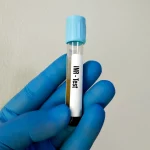What is an IUD?
A copper intra-uterine contraceptive device (IUD, also known as a Cu-IUD or ‘coil’) is a T-shaped implant made of plastic and copper that is placed in your uterus (womb) to prevent you from becoming pregnant.
An IUD is a non-permanent (reversible) method of female contraception. Your healthcare professional can remove it at any time you choose.
What are the benefits of an IUD?
You or your partner should not need to use another method of contraception while the IUD is in place.

Are there any alternatives to an IUD?
There are other non-permanent methods of female contraception.
- A levonorgestrel intrauterine system
- hormone implants
- oral contraceptive pill
Sterilisation is a permanent method of female contraception.
The only safe, non-permanent method of male contraception is to use a condom, but the risk of failure is higher.
A vasectomy is a permanent method of male contraception.
What does the procedure involve?
The procedure usually takes about 10 minutes.
Your healthcare professional will examine your vagina to check the size and position of your womb. They will then insert a speculum (the same instrument used for a smear test) into your vagina.
Your healthcare professional will place the IUD inside your womb. They will cut the strings used to remove the IUD, leaving about 3 centimetres of the strings deep inside your vagina.
What complications can happen?
Some complications can be serious.
- allergic reaction to the equipment, materials or medication
- vasovagal reaction
- lost strings, if your healthcare professional cannot feel or see the strings at the top of your vagina
- lost IUD
- making a hole in your womb
- infection
- increase in period pain and bleeding
- failure of the IUD
- pregnancy problems
How soon will I recover?
You will have some vaginal bleeding and mild cramping that should last for only a few days as your body gets used to the IUD.
You should be able to return to work and normal activities the day after your procedure.
Regular exercise should improve your long-term health. Before you start exercising, ask the healthcare team or your GP for advice.



